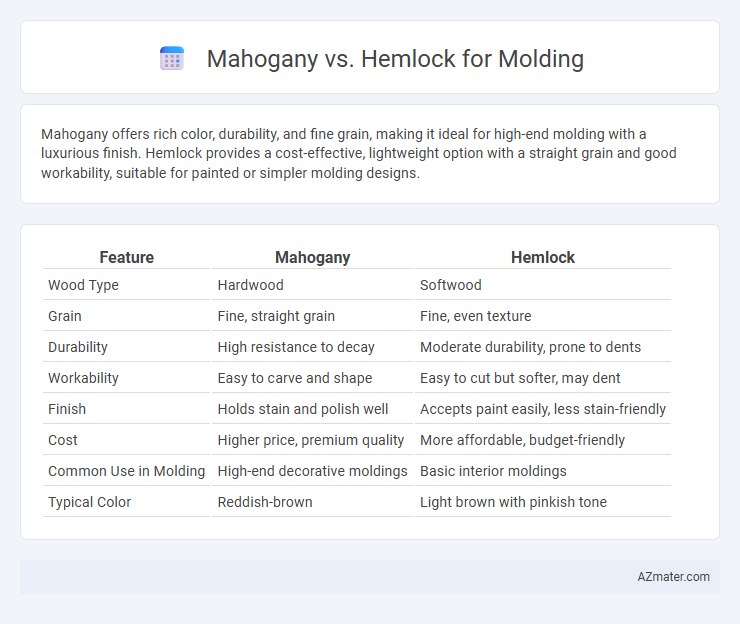Mahogany offers rich color, durability, and fine grain, making it ideal for high-end molding with a luxurious finish. Hemlock provides a cost-effective, lightweight option with a straight grain and good workability, suitable for painted or simpler molding designs.
Table of Comparison
| Feature | Mahogany | Hemlock |
|---|---|---|
| Wood Type | Hardwood | Softwood |
| Grain | Fine, straight grain | Fine, even texture |
| Durability | High resistance to decay | Moderate durability, prone to dents |
| Workability | Easy to carve and shape | Easy to cut but softer, may dent |
| Finish | Holds stain and polish well | Accepts paint easily, less stain-friendly |
| Cost | Higher price, premium quality | More affordable, budget-friendly |
| Common Use in Molding | High-end decorative moldings | Basic interior moldings |
| Typical Color | Reddish-brown | Light brown with pinkish tone |
Introduction: Comparing Mahogany and Hemlock for Molding
Mahogany offers rich color and fine grain, making it a premium choice for decorative molding with exceptional durability and resistance to warping. Hemlock provides a more affordable alternative with a lighter color, uniform texture, and ease of working, though it is softer and less resistant to dents. Selecting between Mahogany and Hemlock depends on balancing aesthetic preferences, budget constraints, and specific application requirements for molding projects.
Overview of Mahogany Wood Characteristics
Mahogany wood is prized for its rich reddish-brown color, fine and even grain, and exceptional durability, making it an ideal choice for high-quality molding. It offers natural resistance to decay and insect damage, which enhances longevity in interior applications. Its smooth texture allows for precise detailing and a polished finish, setting it apart from the lighter, softer hemlock commonly used in less decorative molding.
Key Features of Hemlock Wood
Hemlock wood is lightweight yet strong, making it an excellent choice for molding that requires easy handling and durability. Its fine, even texture and straight grain provide a smooth finish suitable for intricate molding designs. Hemlock also offers good dimensional stability and resistance to warping, ensuring long-lasting structural integrity in interior trim applications.
Durability: Mahogany vs Hemlock
Mahogany offers superior durability for molding due to its dense, oily grain that resists moisture, decay, and insect damage better than Hemlock. Hemlock, a softer and lighter wood, is more prone to dents, scratches, and warping in high-traffic or humid environments. Choosing Mahogany ensures long-lasting molding with minimal maintenance, especially in areas exposed to varying weather conditions.
Workability and Machinability Differences
Mahogany offers superior workability due to its fine, straight grain and uniform texture, allowing for smooth shaping and detailed carving in molding applications. Hemlock, while generally easier to machine, tends to have a coarser grain and can splinter more readily, which may require sharper tools and slower feed rates to achieve clean cuts. The machinability of mahogany is enhanced by its natural oils that reduce tool wear, whereas hemlock's lower resin content necessitates more frequent blade maintenance to maintain precision in molding production.
Aesthetic Appeal: Grain, Color, and Finish
Mahogany offers a rich, reddish-brown color with a straight, fine grain that produces a smooth, polished finish, making it highly desirable for elegant molding designs. Hemlock features a lighter, creamy to pale brown hue with a subtle grain pattern, yielding a more understated, natural look that complements rustic or contemporary interiors. The deep, warm tones of mahogany create a luxurious, classic aesthetic, while hemlock's softer appearance lends versatility and a fresh, clean finish to various molding applications.
Cost Comparison: Mahogany vs Hemlock
Mahogany molding commands a higher price due to its dense grain, rich color, and durability, often ranging from $15 to $25 per linear foot, whereas Hemlock is more budget-friendly, typically costing between $3 and $7 per linear foot. While Mahogany offers superior resistance to wear and an elegant finish ideal for high-end projects, Hemlock provides a cost-effective option with adequate strength and a lighter appearance suitable for standard interior moldings. Choosing between the two depends on balancing budget constraints with aesthetic and longevity preferences for molding applications.
Suitability for Various Molding Applications
Mahogany offers superior durability and a rich, deep color ideal for high-end molding applications such as crown molding and wainscoting, providing both strength and aesthetic appeal. Hemlock, being lightweight and easy to work with, is best suited for interior trim and simple molding projects where budget and ease of installation are priorities. Both woods adapt well to staining and finishing, but mahogany's natural resistance to warping makes it more suitable for intricate, long-lasting molding designs.
Maintenance and Longevity
Mahogany molding offers superior durability and requires minimal maintenance due to its dense grain and natural resistance to decay and insects. Hemlock molding is more affordable but demands regular sealing or painting to prevent moisture damage and warping over time. Choosing mahogany ensures longer-lasting molding with less upkeep, making it ideal for high-traffic or moisture-prone areas.
Final Recommendation: Choosing the Best Wood for Molding
Mahogany offers a rich, deep color and exceptional durability, making it ideal for high-end molding projects where aesthetics and longevity are priorities. Hemlock provides a more affordable, lightweight option with a fine, straight grain that paints well, suited for budget-conscious or painted molding applications. For long-lasting, visually striking molding, mahogany is the preferred choice, while hemlock is better for versatile, cost-effective solutions.

Infographic: Mahogany vs Hemlock for Molding
 azmater.com
azmater.com